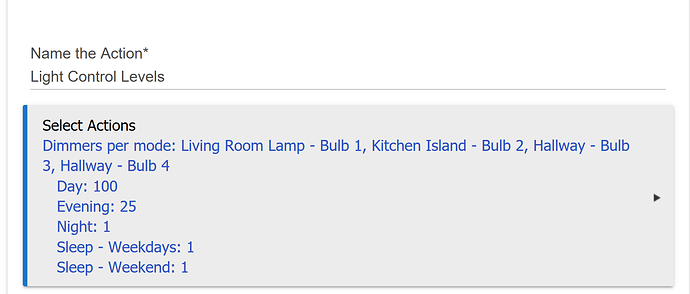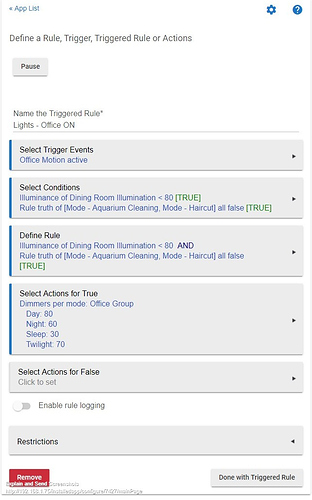I have the following action set up. Do I have to have a rule trigger it or does it automatically trigger based off of mode changes?
An action is just that, an action. It has to have some type of trigger, either the result of an event or the truth (true/false) of a condition or a combination of the two (triggered condition).
The actions you have device will control the levels based on the "mode" that the HE is in at the time of the trigger.
Example of a triggered condition:
In this example the office motion sensor will set the office lights to the specified level based on the current mode, but only if the conditions (illuminance of dining room sensor and rule truth of specified rules are false at the time of the motion becoming active).
@halfrican.ak You have a mode named "Mode - Aquarium Cleaning"??? Can you share the details behind that? I may have to make a mode like that!
I have two "sub" modes that aren't actually modes but rather virtual switches that I use to restrict/change some of the automations in specific areas without affecting the rest of the automations.The reason I use a "virtual switch" is that I'm able to control it by voice (google home integration) or a dashboard switch tile.
In my example I use "Aquarium Cleaning Mode" to automate:
- Turn off water heater, hood light, filters, and disable alarms for water temperature.
- Set a specific color temperature, and light level (independent of the actual mode)
- Restrict the automations of the actual mode from changing any of the above settings until I turn off the switch.
In a nutshell I use these sub-modes to override system wide automations temporarily during specific tasks.
Love it!!! I haven't finished setting up my FishNet yet (using ReefPi).
You just gave me some ideas! Thanks mate!
If i didn't want to be able to control these sub-modes via the dashboard or google assistant I would probably just use a private or global variable boolean to do the same thing.
I use actions when I want something to happen after the main rule is disabled. For example, with notifications, I don't want to be notified again for a particular notification, so I disable the notification rule's PB within the notification itself. But i still want the notification light to turn off some minutes later, so I trigger an action with a delay in it. If i were to put that into the 1st rule, it wouldn't happen because the PB is not false. But it will because the separate action is now triggered.



